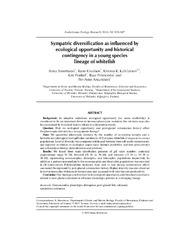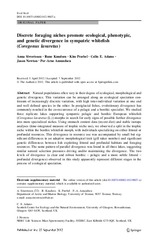| dc.contributor.advisor | Knudsen, Rune | |
| dc.contributor.author | Siwertsson, Anna | |
| dc.date.accessioned | 2012-10-22T11:54:12Z | |
| dc.date.available | 2012-10-22T11:54:12Z | |
| dc.date.issued | 2012-08-24 | |
| dc.description.abstract | How new species are formed is still a major question in evolutionary biology. In ecological speciation, natural selection drives the evolution of slight distinctions between individuals into extensive differences between species. In this thesis, early stages of an ecologically driven speciation process are addressed using ecological and morphological data from a large number of European whitefish (Coregonus lavaretus) populations in northern Fennoscandia.
Northern Fennoscandia is an area scattered with lakes created during the glacial retreat (~10-12 kyr BP). Many of these lakes are inhabited by one or up to three different morphs of whitefish. As many other temperate freshwater fishes, whitefish typically diverge into pelagic and littoral resource specialists, the densely rakered (DR) and the large sparsely rakered (LSR) morph, respectively. Parallel within-lake divergence is the most probable origin of these sympatric morphs. In addition, a third whitefish morph (the small sparsely rakered; SSR), specializing on profundal resources, was recently described in a few lakes in the area. The aims of this thesis were to explore and document the phenotypic diversity of whitefish in northern Fennoscandia, and to investigate some of the factors limiting the level of diversity reached within each lake. Further, the ability of LSR whitefish morphs to utilize profundal resources was explored, as this is a probable origin of profundal specialist SSR morphs.
Based on the distribution of gill raker number, a temporally stable morphological trait in the studied populations, I have documented a continuum of increasing diversity in northern Fennoscandian whitefish. This whitefish diversity comprises mono (only LSR), di- (LSR and DR), and tri-morphic (LSR, DR and SSR) populations, in addition to intermediate stages between them. Within three different lakes with dimorphic whitefish populations, some individuals of the LSR morph were specialized to exploit profundal resources. This could indicate an incipient evolution towards a profundal specialist morph (SSR) in some dimorphic lakes. Ecological opportunity (lake size and productivity) is likely a prerequisite for whitefish to diverge, although limitations related to the colonization history also were present.
In conclusion, there is astonishing parallel divergence in ecology, morphology and genetics along a continuum of increasing diversity in whitefish. Thus, ecologically-based natural selection is likely driving the divergence, promoting reproductive isolation and incipient ecological speciation in northern Fennoscandian whitefish populations. | en |
| dc.description.doctoraltype | ph.d. | en |
| dc.description.popularabstract | Will arrive later | en |
| dc.description | Papers 1 and 4 of this thesis are not available in Munin: <br/>1. Anna Siwertsson, Rune Knudsen and Per-Arne Amundsen: 'Temporal stability in gill raker numbers of subarctic European whitefish populations', Advances in Limnology (2012), vol. 63:229-240. Available at <a href=http://www.schweizerbart.de/papers/adv_limnology/detail/63/77932/Temporal_stability_ingill_raker_numbers_of_subarct>http://www.schweizerbart.de/papers/adv_limnology/detail/63/77932/Temporal_stability_ingill_raker_numbers_of_subarct</a> <br/>4. Anna Siwertsson, Rune Knudsen, Colin Adams and Per-Arne Amundsen: 'Replicated morphological divergence supports incipient ecological morph formation in European whitefish (Coregonus lavaretus)', (manuscript) | en |
| dc.identifier.isbn | 978-82-8266-039-6 | |
| dc.identifier.uri | https://hdl.handle.net/10037/4566 | |
| dc.identifier.urn | URN:NBN:no-uit_munin_4298 | |
| dc.language.iso | eng | en |
| dc.publisher | University of Tromsø | en |
| dc.publisher | Universitetet i Tromsø | en |
| dc.rights.accessRights | openAccess | |
| dc.rights.holder | Copyright 2012 The Author(s) | |
| dc.rights.uri | https://creativecommons.org/licenses/by-nc-sa/3.0 | en_US |
| dc.rights | Attribution-NonCommercial-ShareAlike 3.0 Unported (CC BY-NC-SA 3.0) | en_US |
| dc.subject | VDP::Mathematics and natural science: 400::Zoology and botany: 480::Limnology: 498 | en |
| dc.subject | VDP::Matematikk og Naturvitenskap: 400::Zoologiske og botaniske fag: 480::Limnologi: 498 | en |
| dc.subject | VDP::Mathematics and natural science: 400::Zoology and botany: 480::Ecology: 488 | en |
| dc.subject | VDP::Matematikk og Naturvitenskap: 400::Zoologiske og botaniske fag: 480::Økologi: 488 | en |
| dc.title | Diversity along a speciation continuum : ecology and morphology of northern European whitefish (Coregonus lavaretus) | en |
| dc.type | Doctoral thesis | en |
| dc.type | Doktorgradsavhandling | en |


 English
English norsk
norsk


